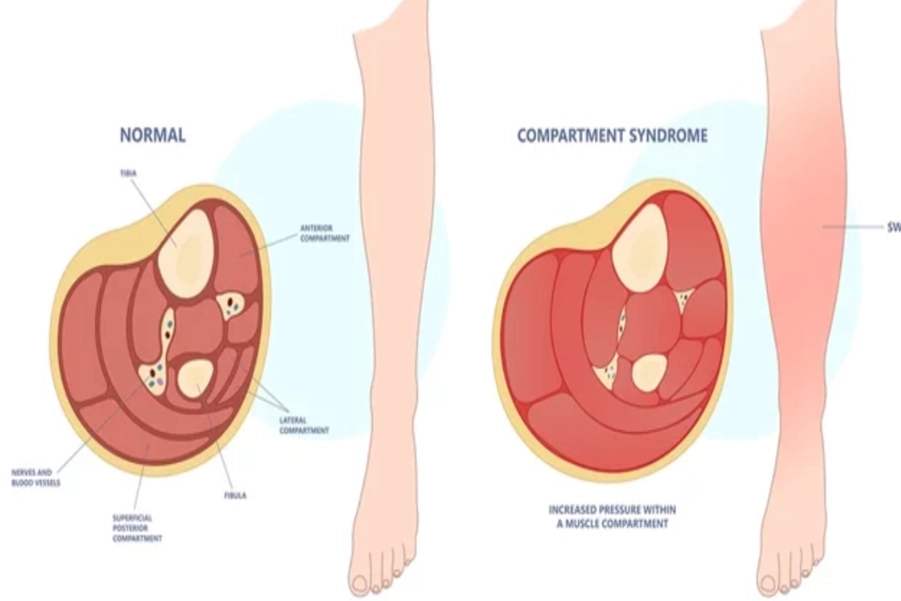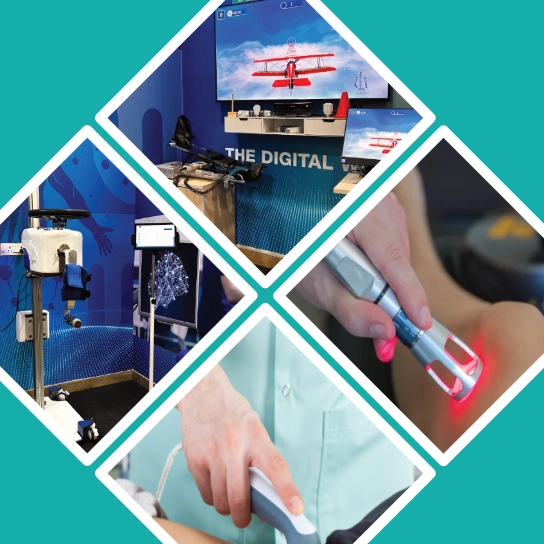WHAT WE TREAT
Compartment Syndrome
Best Physiotherapist in Delhi
Explore the complexities of compartment syndrome, its causes, symptoms, and effective treatment strategies. Learn how timely recognition and intervention can help restore limb health and function.
Recognizing, Treating, and Restoring Limb Health
Compartment syndrome is a serious medical condition that can impact limb health and function. This comprehensive guide delves into the complexities of compartment syndrome, helping you understand its causes, symptoms, and offering effective treatment strategies. Discover how timely recognition and intervention can help restore limb health and function.
Demystifying Compartment Syndrome
Compartment syndrome is a condition in which pressure within a muscle compartment in the body becomes excessively high. This elevated pressure can affect blood flow, leading to tissue damage and potentially permanent impairment.

Causes of Compartment Syndrome
Compartment syndrome arises from increased pressure within a closed muscle compartment, which compromises blood flow and tissue health. Key causes include:
Trauma:
- Direct injuries such as fractures, crush injuries, or severe contusions.
Overexertion:
- Intense physical activity, especially in unconditioned individuals, can lead to exertional compartment syndrome.
Burns and Infections:
- Severe burns or infections may cause swelling and increased compartment pressure.
Acute vs. Chronic Compartment Syndrome
Acute Compartment Syndrome (ACS):
- A medical emergency caused by trauma or other acute events.
- Requires immediate surgical intervention (fasciotomy) to prevent permanent damage.
Chronic Exertional Compartment Syndrome (CECS):
- Develops gradually due to repetitive activities like running or cycling.
- Symptoms typically resolve with rest and may be managed conservatively or surgically if persistent.
Symptoms and Diagnosis
Symptoms:
- Severe pain disproportionate to the injury.
- Swelling and a feeling of tightness in the affected limb.
- Numbness, tingling, or weakness, indicating nerve involvement.
Diagnosis:
- Physical Examination: Assessment of pain, swelling, and neurological signs.
- Compartment Pressure Measurement: Direct measurement to confirm elevated pressures.
Management of Compartment Syndrome
Acute Cases:
- Fasciotomy: Surgical decompression by cutting the fascia to relieve pressure.
- Intravenous Fluids: To stabilize circulation and tissue perfusion.
- Pain Management: Medications to control severe pain.
- Wound Care: Managing necrosis or tissue damage caused by prolonged ischemia.
Chronic Cases:
- Activity Modification: Avoiding activities that trigger symptoms.
- Physiotherapy: To improve strength and prevent recurrences.
- Surgical Intervention: Reserved for persistent or debilitating cases.
Rehabilitation and Recovery
After fasciotomy or other interventions, rehabilitation is vital to restore limb function. Key components include:
- Physical Therapy: Exercises to improve strength, range of motion, and flexibility.
- Progressive Loading: Gradual reintroduction of activities to prevent reinjury.
- Scar Management: Techniques to improve mobility and reduce adhesions.
Prevention Strategies
- Gradual Conditioning: Slowly increasing exercise intensity to avoid overloading muscles.
- Hydration: Maintaining adequate hydration to prevent muscle swelling.
- Avoiding Overexertion: Balancing activity with adequate rest.
- Stretching: Incorporating stretches to enhance muscle flexibility and circulation.
Role of Physiotherapy
Physiotherapy is central to managing and recovering from compartment syndrome. Key approaches include:
- Rest and Activity Modification: Allowing tissues to heal and adapting activities to prevent recurrence.
- Ice and Heat Therapy: Ice for inflammation reduction; heat for promoting circulation and healing.
- Strengthening and Stretching Exercises: Improving muscle balance and restoring range of motion.
- Manual Therapy: Techniques to release tension, improve blood flow, and enhance mobility.
- Supportive Measures: Taping or bracing to reduce strain and provide stability.
- Education: Guidance on proper biomechanics and injury prevention strategies.
Timely Intervention and Safeguarding Limb Health
Compartment syndrome demands prompt attention to prevent irreversible muscle and nerve damage. A combination of surgical intervention, physiotherapy, and preventive measures can effectively manage the condition. If you suspect symptoms, seek immediate medical evaluation to ensure accurate diagnosis and treatment.

Cutting-Edge Technology
Our commitment to using the best technology extends to various aspects of physiotherapy:
- Robotic Assistance: We employ robotics for gait training, aiding patients with mobility impairments. These devices facilitate improved motor control and muscle activation.
- Electrotherapy: Techniques like TENS, IFT, and Ultrasound Therapy are used to target pain relief and accelerate tissue healing.
- Virtual Reality (VR): We utilize VR and interactive gaming for engaging and enjoyable rehabilitation, increasing patient motivation and compliance with treatment.
Frequently Asked Questions
Reach out to us if you have further Questions - We're here to help!
Q1: Can compartment syndrome affect any part of the body?
A1: Compartment syndrome can occur in various parts of the body, but it is most common in the lower leg.
Q2: Is compartment syndrome always caused by trauma?
A2: No, compartment syndrome can also result from exertion, burns, and infections.
Q3: Are there any long-term effects of compartment syndrome?
A3: Timely intervention can minimize long-term effects, but in severe cases, muscle or nerve damage may be permanent.
Q4: Can compartment syndrome recur after treatment?
A4: Recurrence is rare after successful treatment, but it can happen, especially if the underlying cause is not addressed.
Q5: How long does recovery take after fasciotomy?
A5: Recovery duration varies, but it may take several weeks to months to regain full limb function.
Timely recognition and intervention are crucial in the management of compartment syndrome. Understanding the condition’s causes, symptoms, and treatment options is essential for effective intervention and the restoration of limb health and function. If you suspect compartment syndrome, seek immediate medical attention for proper diagnosis and treatment.
Have Questions or Need Assistance?
Don’t hesitate to reach out to us:
Book Appointment with Experts
- Call/WhatsApp: +9818911195
- Book Appointment with Experts
We are here to lend our support on your journey toward improved movement and overall well-being.
See all Blogs & Articles
See all Conditions we Treat
Note: Content provided here is for informational purposes only and is not a substitute for professional medical advice or diagnosis. If you believe you are experiencing pain or any other health-related issue, it is important to seek the advice of qualified healthcare professionals for a proper evaluation and treatment plan.


